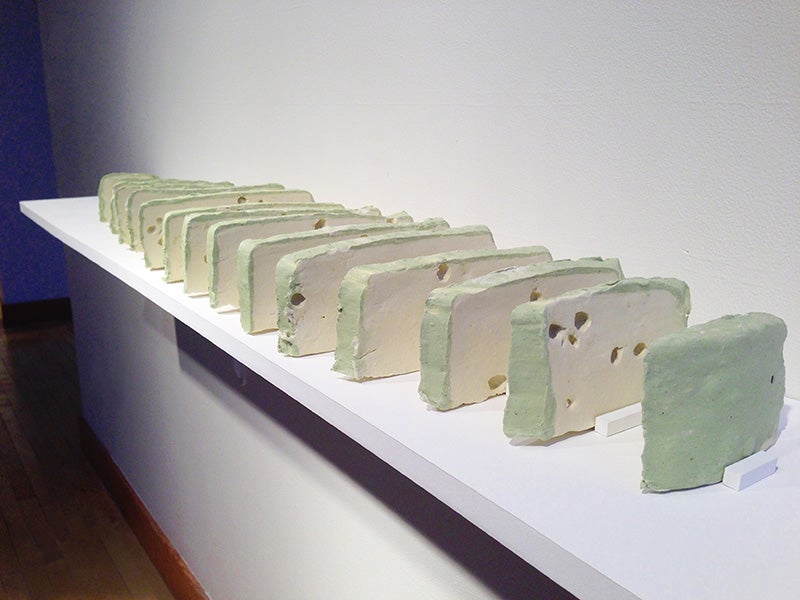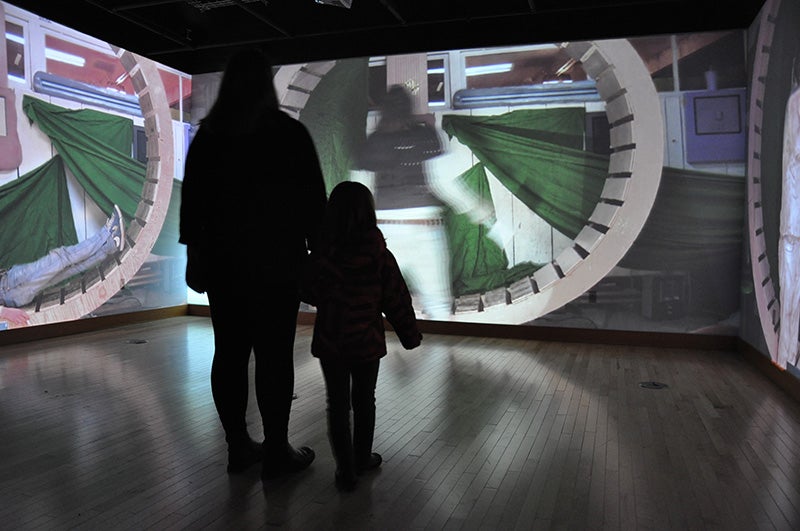The 2016 UO Art MFA 2nd Year Exhibition, featuring the work of second-year MFA students in the UO Department of Art, will continue at White Box, 24 NW First Avenue in Portland, through January 30. The exhibition shows the wide range of offerings in the UO’s art program, including collage, video, ceramics, drawing, sculptural bricolage, puppetry, and painting.
“If there is a common thread running through the work of these artists, it is that each refuses expected responses to subject-object relationships, and each artist mediates these relationships vis-à-vis surprising and experimental processes and use of materials,” says Christopher Michlig, director of graduate studies for the UO Department of Art.
The MFA candidates exhibiting their work include Lee Asahina, Andrew Douglas Campbell, Chelsea Couch, Mandy Hampton, Ron Linn, Joe Moore, Mary Margaret Morgan, Meril Wallace, and Esther Weng.

Above: Digital Arts program alumna Braeden Cox checks out Ron Linn’s fluvial knot, graphite on paper, wood, dimensions variable. Photo by Sabina Poole.
“The quality and diversity of the art displayed by these graduate students highlights their preparedness for this representation and confidence in the future of their individual careers," says Cris Moss, White Box director and curator.
Work by Campbell, Couch, and Weng demonstrate the artist-students’ scope of talent.
Campbell’s installation uses sewing thread draped on Plexiglas, “letting the thread pile up and tangle and the threads, sandwiched between two sheets of Plexi, end up functioning just like line drawings,” he says.
Campbell says the intent of his work is to “make sense, for myself, out of human connection—the ways that someone can and cannot make themselves known to another. A lot of that has to do with identity, how we choose to portray ourselves, and the opportunities we are given to portray ourselves. Recently I made some work that dealt with a failure to communicate anxiety. And then after that I made some work about the moment of and act of a simple touch.”
For her part, Couch crosses media to engage video, sculpture, and painting “into an ephemeral and vibrational projected space.”
She characterizes her work as attempting “to combat issues of representation utilizing the human, specifically female, body. … Oftentimes we feel so disconnected and our experiences can be so cold and systematic. The visual arts give at least a brief moment of pause. In that pause there is an infinite array of possibilities for what happens next.”
Weng’s current focus employs acrylic, ink, sculpture, and video. For her ceramic piece in the show, she added colorants and organic burnout materials to the clay to achieve color and texture.
“The physical concreteness of the clay offers me the opportunity to simulate real life objects and create uncanny spaces of encounter for the viewer,” she says. Her recent explorations of video projection mapping, she adds, “are helping me gain more understanding to illusionistic, positive, and negative spaces.”

Above: MFA candidate Krista Heinitz and her daughter, Aurora, smell Mary Margaret Morgan’s scented piece Manifest Whatever II, tempered glass, extension cord. Photo by Sabina Poole.
Notes Michlig, “There is a momentum in each artist’s practice, represented in this exhibition by works that index highly discursive and energetic artistic activity, hinting at both the temporal nature of an artists’ labor as well as the enduring visual and conceptual momentum that occurs as the result.”
Being able to exhibit at the White Box, Moss notes, “is a wonderful opportunity for UO grad students. The gallery has a prominent reputation for high-quality programming and gets ample local and national recognition. With its location in the heart of Portland, the venue serves as a prime public platform to highlight the academic strength of the School of Architecture and Allied Arts and the University of Oregon as a whole.”
Given the range of people expected to view an exhibition in downtown Portland, Campbell says he expects a wide variety of reactions.
“While I was working on these drawings, I got up and made a note on the wall next to one of them. It read ‘beautiful curious and a little bit too much.’ I think that is my ideal reaction [by a viewer], but really it is not up to me to dictate the terms for viewers to enjoy the work. If someone walks away and remembers my work later, [if] some part of it gets stuck with them, then everything is all right by me, I'm satisfied that I have done a good job.”
The MFA program at UO is interdisciplinary, with students encouraged to work across disciplines. The program offers focus in sculpture, photography, painting, printmaking, digital arts, ceramics, fibers, and jewelry and metalsmithing. Approximately thirty students constitute a tight-knit community of MFA candidates, who have frequent contact with professionally active faculty members, visiting artists and curators, and other relevant art professionals. Graduate teaching fellowships provide opportunities for significant financial support as well as teaching and professional experience.

Above: Untitled, ceramic, dimensions variable, 2015, by Esther Weng. Weng added colorants and organic burnout materials to the clay to achieve color and texture. Image courtesy Esther Weng.

Above: I Tried My Best To Get It Done, a digital video by Joe Moore, captivates MFA candidate Krista Heinitz and her daughter at the opening reception. Photo by Sabina Poole.
